Research results

Advisory Panel Update: Midsummer 2025
above: experimental field layouts at uk's horticultural research farm in lexington, kentucky.
To continue to assess the impacts that fine-mesh row covers have on insect pests and the best weed management practices for weed control beneath the row covers, each state team will repeat their 2024 experiments with some modifications.
KY are undertaking 4 pest management experiments in 2025 across spring bok choy, summer eggplant and cucumbers, and fall napa cabbage and a weed management experiment in summer eggplant.
IA will have three pest management experiments in 2025 across spring broccoli, summer eggplant, and fall napa cabbage and one weed management experiment in spring broccoli.
NY will have two experiments that are integrated pest and weed management in summer muskmelon and fall red cabbage.
Each state team is continuing to collect economic data on all of the main pest and weed management experiments. Analysis of 2024 data is nearly complete.
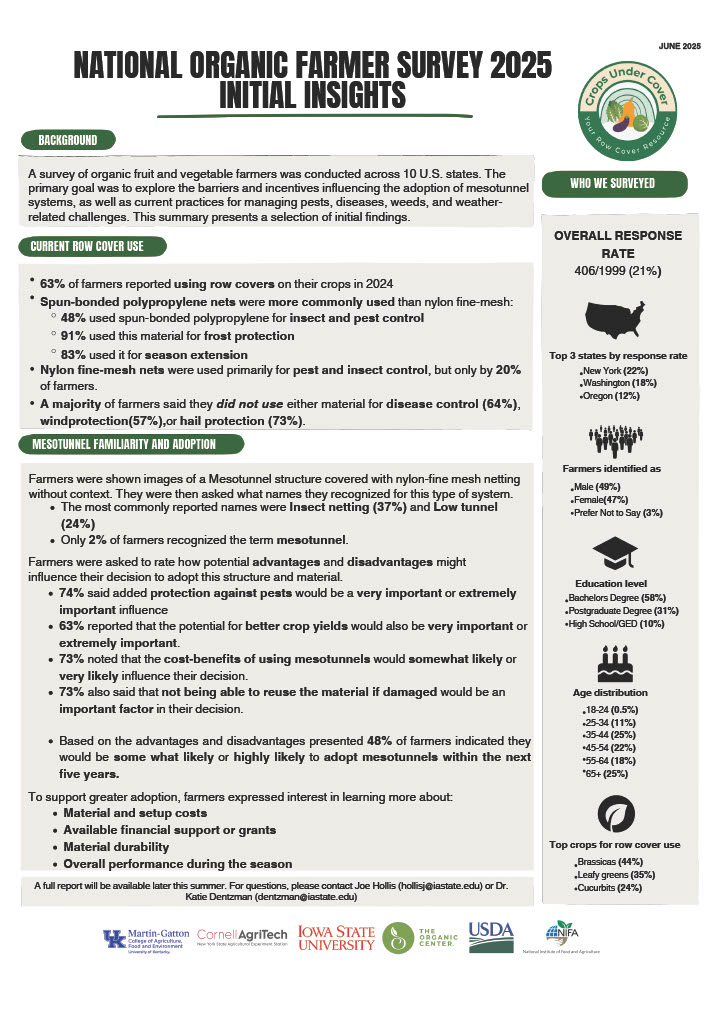
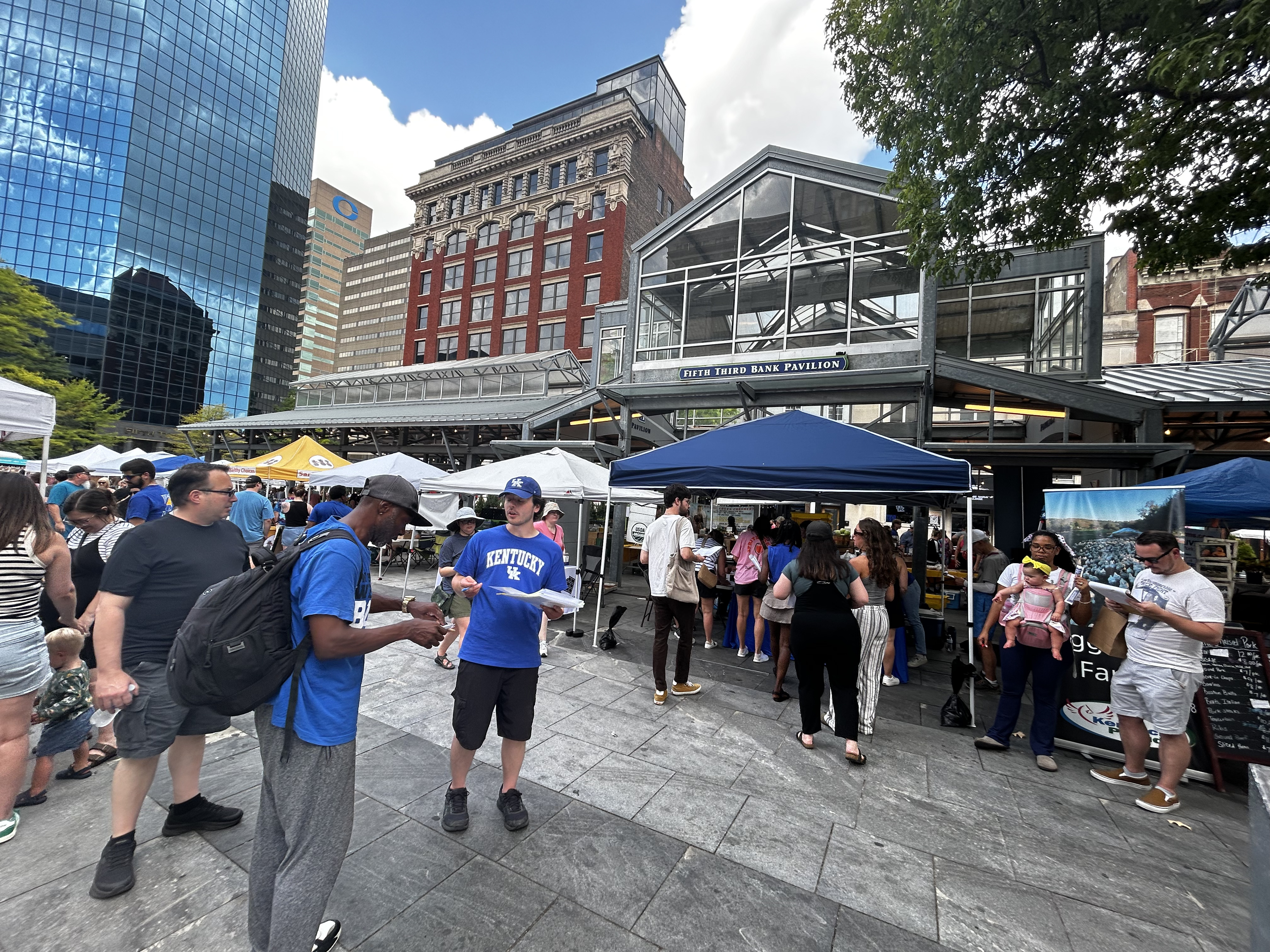
above: recruiting volunteers encourage lexington farmers market attendees to participate in the wtp survey.
A "Willingness to Pay" (WTP) survey was conducted at the Lexington, KY Farmers markets in July 2025. This survey is designed to understand consumer’s perceptions on the use of row covers, plastics, and insecticide use on the production of cucumbers. Roughly 900 consumers were surveyed!
Our social media team is collaborating with The Organic Center to boost some of our most popular reels on Instagram. We are currently trialing two ad campaigns to see how the boos amount, content type, and timing affect engagement.
- Ad Campaign 1 will test content effectiveness by comparing how different types of content perform with the same amount of spending.
- Ad Campaign 2 will test boosting budget by determining if the amount spent significantly affects engagement when the content type is similar.
The first ad campaign began on July 7, and the second began on July 14.
Year 1 Report: 2024
Insect pests, weeds, and diseases pose significant challenges for organic vegetable and fruit growers. Additionally, certain climate events, such as heavy rains, drought, fluctuating temperatures, and high winds, have become increasingly concerning. This project, funded by the USDA Organic Agriculture Research and Extension Initiative, investigates the effectiveness of netting row cover protection systems as a potential solution to these challenges. Our research team from the University of Kentucky, Iowa State University, Cornell University, and The Organic Center aims to address these issues in the Southeast, Midwest, and Northeast.
The project’s main objectives are to:
Obj. 1) Evaluate the efficacy of netting row covers for pest, disease, and weather protection while optimizing weed management strategies under row covers.
Obj. 2) Assess the cost-effectiveness of these protection systems.
Obj. 3) Understand organic farmer, consumer, and industry perceptions of row covers.
Obj. 4) Communicate findings regarding protective row covers to growers, consumers, and industry through a national outreach effort.
The project began in September of 2023, and a wide range of activities in Year 1 have moved forward.
Highlights:
- In 7 of 9 pest management experiments, protective row covers increased marketable yield by an average of ~3.6 times that of the control treatments. However, yield benefits varied substantially by crop and by state.
- Row covers may offer some weather protection, as high wind speeds were 4.9 times higher in uncovered plots. Temperature, humidity, and other variables remain to be assessed.
- In 6 of 7 weed management experiments, landscape fabric out yielded cover crop treatments by an average of 4.1 times under row covers. On average, cover crops did not increase yield compared to bareground (mowed).
- A national survey of organic growers was administered across 10 states to understand grower perception and use of row covers for pest management. Over 300 surveys have already been collected.
- Two websites were created to deliver online outreach materials to organic growers and consumers.
- As of 2/25, 8 YouTube posts have received over 500 views and 8 Instagram posts had over 7,800 profile views and reached over 2,900 accounts. In 2024-25, we presented at 21 grower, industry, and academic events. On-farm collaborations were initiated to understand the efficacy, grower acceptance, and barriers to adoption.
What are pest protective row covers?
Pest protective row covers are fine-mesh netting used for insect exclusion in fruit and vegetable production. Row covers are draped over hoops and secured to the ground by a weight. Note that some may refer to these systems as low-tunnels, mesotunnels, or other names.
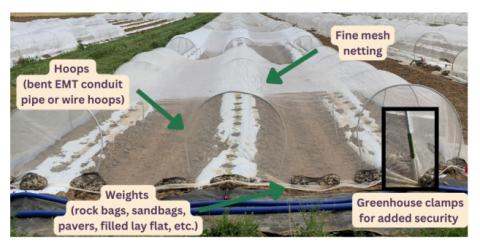
Above: Fine-mesh netting secured over tall hoops.
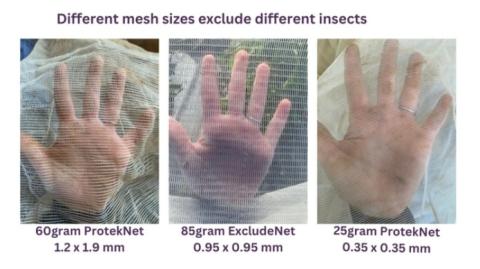
Above: 3 different grades of fine-mesh netting.
Objective 1. Evaluating Efficacy of Protective Row Covers
1.1. Pest and weather management. Nine pest management experiments were conducted in KY, IA, and NY in 2024 at University Experimental Organic Farms. Experiments assessed the efficacy of fine-mesh row covers for pest, disease, and weather protection compared to uncovered controls and organic insecticide treatments. Additionally for some experiments, two different row cover treatments were integrated (plots were 30ft long, triple beds, N=4 per treatment; except only single beds in green beans [KY] and napa cabbage [IA]). Experiments were conducted in the spring, summer, and fall growing seasons in Kentucky and Iowa, and in the summer and fall growing seasons in New York.

Above: Experimental setup for an eggplant trial with four treatments replicated in four blocks. Uncovered, untreated control and an organic insecticide treatment plots are uncovered. This photo was taken at flowering, one fine-mesh row cover treatment was removed (appears uncovered), while the other was opened on the ends of the tunnel to allow bee pollination.
Pest management. In 7 of 9 experiments, protective row covers increased marketable yield by an average of ~3.6 times that of the control treatments (Fig. 1). Row covers increased yield relative to uncovered organic insecticide treatments in 4 of 6 experiments although benefits were marginal. Yield benefits from row covers varied substantially by crop and by state. For example, eggplant in Kentucky benefited greatly from row covers (6 times higher yield than organic insecticides); however, in Iowa, no yield increase was observed. In New York, row covers only benefited muskmelon when planted with landscape fabric in the furrows (data not shown). Row covers hindered muskmelon yield when planted with annual ryegrass in the furrows. Further, applying organic insecticides appeared to increase the effectiveness of row covers in bok choy and muskmelon (data not shown).
Weather protection. Each state team deployed sensors to measure the impact of row covers on climate and microclimate (Fig. 2). Variables recorded include: temperature, wind speed, relative humidity, dew point, rainfall, and light. However, these data are time-consuming to analyze and have not been completed to date. In Kentucky, the most drastic and consistent difference observed was the reduction of wind speed. During Hurricane Helene, for example, high winds of up to 30 mph were reduced by 63 percent under row covers. In Kentucky, temperature did not differ significantly across most experiments. Relative humidity was higher under row covers in the summer eggplant trial. Analysis of weather and micro-climate effects will continue in 2025.
1.2 Weed management. In each state, studies were conducted to understand the best weed management strategies in the furrows between raised plasticulture beds under row covers (Fig. 3). In Iowa and Kentucky, landscape fabric was compared to living mulch (cover crops) and bareground controls, whereas in New York, landscape fabric was compared to living mulch. In 6 of 7 experiments, landscape fabric out yielded cover crop treatments by an average of 4.1 times. On average, cover crop treatments did not increase yield compared to bareground (mowed) treatments in Kentucky and Iowa, suggesting cover crops may have a yield consequence. It should be noted that the benefits of landscape fabric were minimal in the spring and fall experiments in Kentucky for bok choy and napa cabbage, possibly because of the slow growth of weeds during these seasons and possibly because of the short days-to-harvest for these crops. Although landscape fabric has increased yield, there are additional labor and material costs and it is unknown whether the yield benefits outweigh the increased costs.
2.1 Economic assessment of all pest and weed management experiments in Obj. 1 were undertaken by each state team. Labor, materials, machinery, and input costs related to field preparation, pest and weed management, and harvest activities were tracked. Yield and produce price points were also collected. A Qualtrics survey was designed and field tested to gather all production costs. Profitability estimates for each experiment are currently being analyzed and reporting is aimed for 2025.
2.2 Rotating row covers. Each state team developed planting strategies to maximize the use of netting materials per year. In KY and IA, spring, summer, and fall experiments were staggered such that the materials from the spring experiment would be reused in the summer and fall. Due to the shorter growing season in NY, the materials were only used in summer and fall. The reuse of row cover materials should improve the profitability by increasing total revenue per lifetime use.
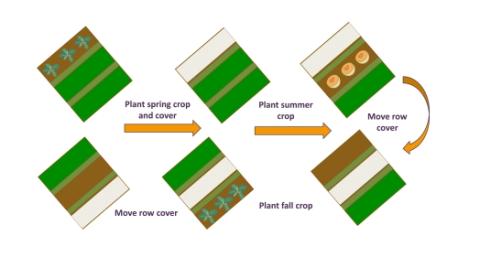
Above: Example of rotating row cover materials through three crops in one growing season.
3.1 Social acceptance of plastic-based protection systems. A national survey questionnaire was developed and deployed to understand organic grower use and perception of row covers and other plastics in organic production. It focused on surveying the top organic producing state in addition to the three focal states. This survey was sent out January 6, 2025. As of February 3, 2025, over 300 responses were received. We currently plan to end the data collection process in early March and begin data analysis March-April 2025.

Above: Distributed and returned surveys by state.
3.2 Consumer perceptions of plastic-based protection systems. A consumer field experiment was designed to study consumer perceptions and willingness to pay for organic vegetables produced with plastic-based protection systems. This field-based study will solicit real customers of farmer’s markets and their preferences for cucumbers grown using row cover versus without. The experiment will take place in the summer of 2025 at farmers markets in Lexington, Kentucky.
An online outreach strategy was developed, including the ‘Crops Under Cover!’ website, The Organic Center Microsite, and social media accounts. As of February 2025, the YouTube channel (@CropsUnderCover) had 8 videos and over 500 views. The Instagram account (@crops_under_cover) had over 7,800 total profile views and reached over 2,900 accounts, thanks in part to collaborative-boosted posts with The Organic Center.
In-person outreach in 2024 was accomplished by presenting at 16 grower or industry-facing conferences, 3 academic groups, and 3 governmental groups.
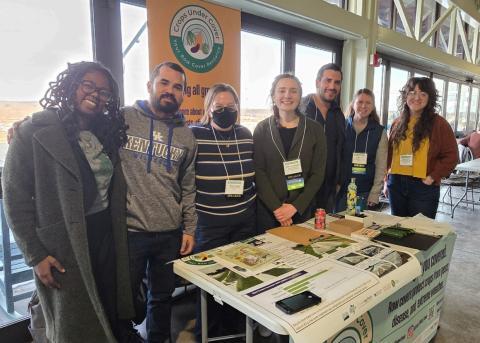
Above: Kentucky team at the 2025 Organic Assiciation of Kentucky Conference.
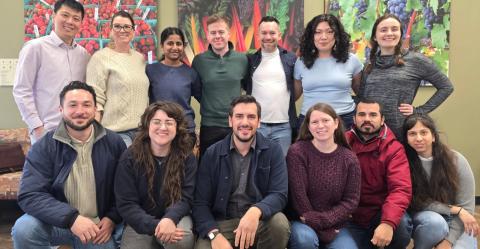
above: Full team at the 2025 in-person meeting in lexington, kentucky.
On-farm collaborations with growers. In 2024, we began on-farm collaborations with growers in Kentucky. In 2025, we will expand to the three states. Through these collaborations, we hope to learn how growers adapt and innovate the deployment of protective row covers and understand the barriers and incentives to adoption.
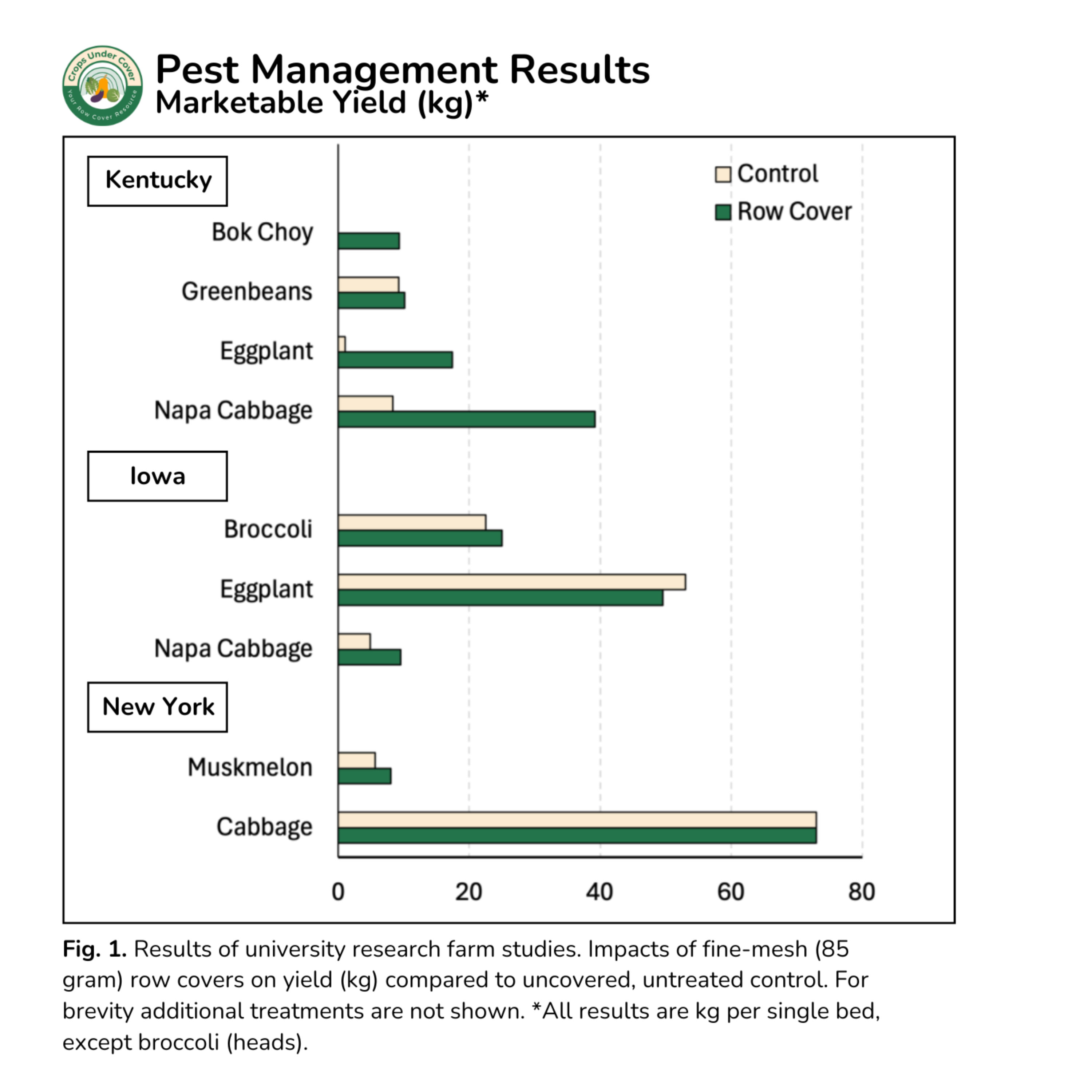
Row covers increased marketable yield compared to the control.
In 7 of 9 experiments, protective row covers increased marketable yield by an average of approximately 3.6 times compared to control treatments. Although row covers increased yield relative to uncovered organic insecticide treatments in 4 of 6 experiments, the benefits were marginal and varied substantially by crop and state.
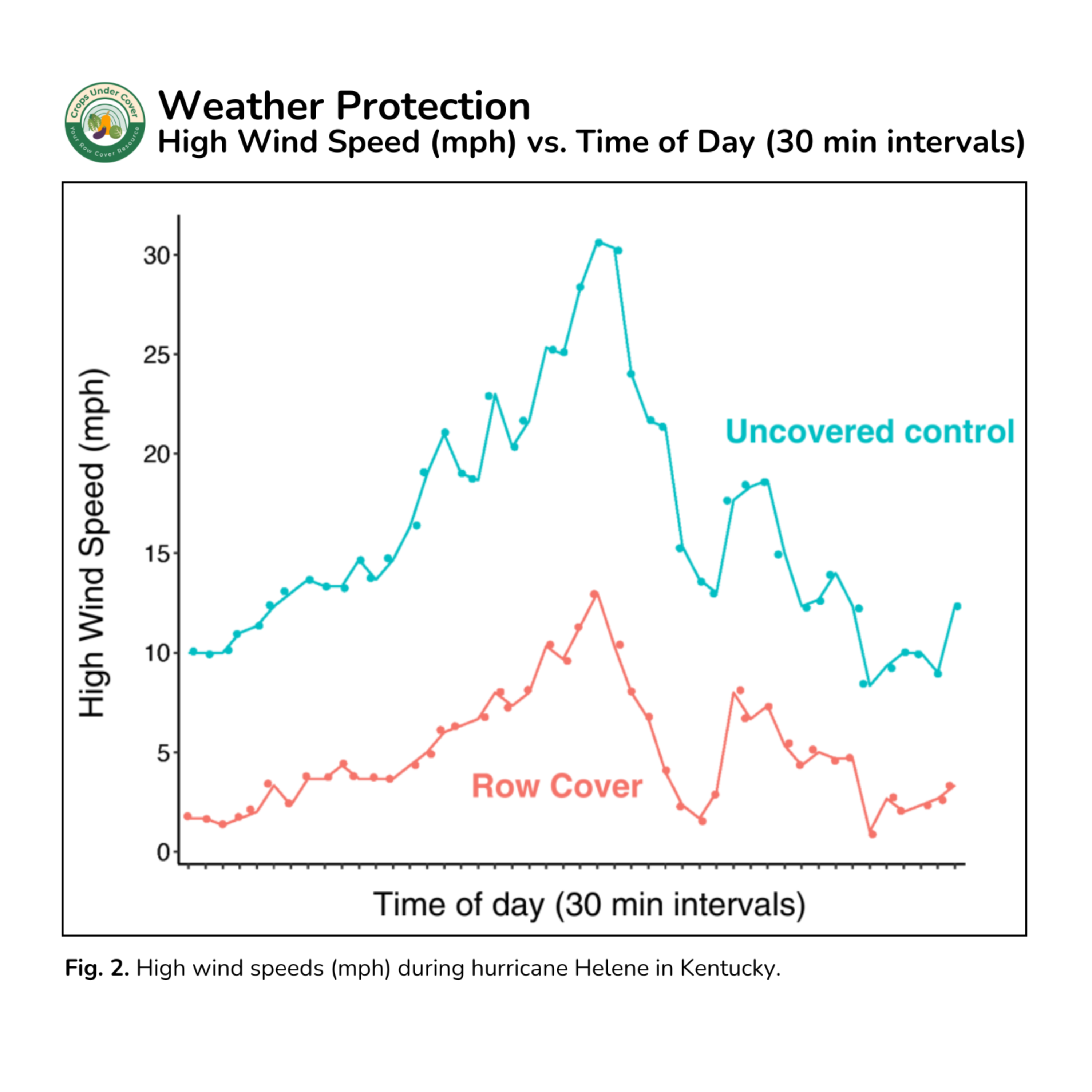
Sensors were deployed to measure the impact of row covers on climate.
Variables recorded include: temperature, wind speed, relative humidity, dew point, rainfall, and light. In Kentucky, the most drastic and consistent difference observed was the reduction of wind speed. During Hurricane Helene, for example, high winds of up to 30 mph were reduced by 63% under row covers.
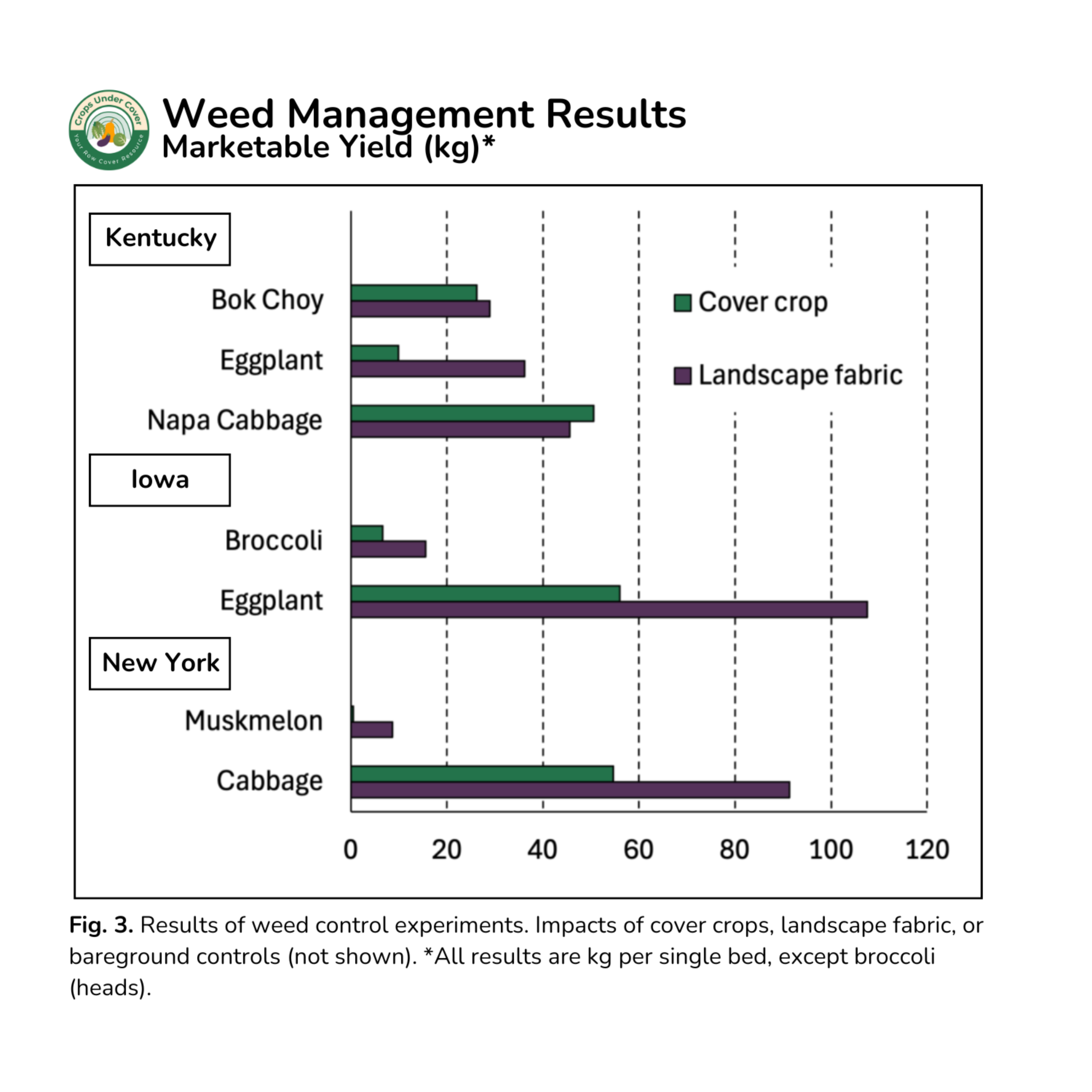
Landscape fabric increased marketable yield compared to cover crops underneath row covers.
In 6 of 7 experiments, landscape fabric out yielded cover crop treatments by an average of 4.1 times. Although landscape fabric has increased yield, there are additional labor and material costs and it is unknown whether the yield benefits outweigh the increased costs.
